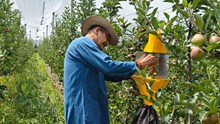
Ramnagar Bhanta, a distinctive variety of brinjal native to the Varanasi region of Uttar Pradesh, is more than just a crop—it is a symbol of cultural heritage, traditional farming, and culinary richness. Cultivated primarily in the districts of Varanasi, Mirzapur, Chandauli, and Sonbhadra, this winter-season vegetable is cherished for its unique taste, exceptional size, and remarkable nutritional benefits.
Ramnagar Bhanta: A Brinjal with Distinction
Taste and Texture
Ramnagar Bhanta is renowned for its rich, slightly smoky flavor, which makes it ideal for rustic North Indian dishes such as bati-chokha, a mashed brinjal delicacy often cooked over an open flame. Its smooth and dense flesh cooks into a creamy consistency, which enhances its appeal in both traditional and contemporary recipes.
Size and Appearance
One of the most striking features of this variety is its size. Each fruit can weigh between 2 to 2.5 kilograms, making it one of the largest cultivated brinjals in India. It undergoes a fascinating transformation in color—starting off as greenish-white and gradually ripening to a golden yellow. This change not only signifies its maturity but also signals its readiness for seed extraction, an important part of traditional farming practices in the region.
Nutritional Richness
Ramnagar Bhanta is not only a culinary gem but also a nutritional powerhouse. It is rich in essential vitamins and minerals such as calcium, iron, and phosphorus, along with B-complex vitamins. Its low calorie and high fiber content make it excellent for digestive and heart health, while its antioxidant properties help in reducing inflammation and preventing chronic diseases.
Botanical Characteristics
Botanically known as Solanum melongena L., this perennial plant—typically cultivated as an annual—can reach heights of up to 150 cm. It has a strong taproot system that supports deep soil penetration, contributing to its resilience in varying conditions. The plant produces large, white flowers and ovate leaves covered in wool-like hairs. Fruiting generally begins 60 to 80 days after sowing.
Cultivation and Geographic Specificity
Ramnagar Bhanta thrives in the sandy loam soils rich in iodine found in the Gangetic plains. The crop grows best during the winter months, with peak fruiting from December to February. Farmers in this region rely on traditional agricultural methods, including organic composting and natural seed preservation, which help maintain the crop’s genetic purity.
The agricultural cycle for Ramnagar Bhanta begins in July with nursery preparation, followed by transplantation in mid-August. Farmers typically maintain a spacing of 75 x 75 cm to support robust root development. Fertilization is done using organic manure along with NPK nutrients. Harvesting is carried out when the fruits reach full size but before they lose their natural gloss. Under optimal conditions, the brinjal can yield between 200 to 500 quintals per hectare and has a shelf life of 10 to 15 days.
Recognition Through the GI Tag
In 2023, Ramnagar Bhanta was granted a Geographical Indication (GI) tag by the Government of Uttar Pradesh through the Department of Agriculture and Farmers Welfare. This official recognition not only safeguards the authenticity of this regional crop but also enhances its value in the market.
The GI tag has opened up new avenues for farmers by allowing them to market Ramnagar Bhanta as a premium product. It has increased consumer demand, particularly during winter and festive occasions like the Bati-Chokha Mahotsav, resulting in improved incomes and livelihoods for local cultivators. The GI status also encourages sustainable agricultural practices and traditional seed-saving methods.
Culinary Uses and Health Benefits
Versatility in Cuisine
Ramnagar Bhanta has long held a prominent place in North Indian kitchens. Apart from bati-chokha, it is widely used in grilled dishes, curries, sautéed vegetable mixes, pickles, and chutneys. Its ability to absorb flavors and its creamy texture make it a favorite among chefs and home cooks alike.
Health Contributions
This brinjal supports cardiovascular health by helping regulate blood pressure and cholesterol levels. It aids digestion and helps prevent colon-related issues due to its high fiber content. It also contributes to better brain function by improving circulation and offers a natural boost to the immune system. Its low glycemic load makes it suitable for individuals managing diabetes.
Cultural and Traditional Significance
Ramnagar Bhanta is deeply interwoven with the cultural fabric of Varanasi. Events like the Lota-Bhanta Mela attract over 100,000 visitors annually, where dishes like bati-chokha take center stage. Similarly, during the Ramnagar Ramlila Festival, tens of thousands of attendees enjoy traditional meals prepared using this prized brinjal, highlighting its enduring cultural relevance.
Ramnagar Bhanta stands as a testament to the rich agricultural and cultural traditions of eastern Uttar Pradesh. With its GI tag recognition, this unique brinjal is not only protected but poised for greater awareness and market reach. As more people discover its unmatched qualities, Ramnagar Bhanta will continue to thrive—preserving the legacy of generations of farmers and sustaining local economies.
















